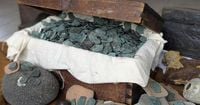Off the sun-drenched shores of Florida’s Atlantic coast, a stretch known as the “Treasure Coast” has once again lived up to its name. This summer, a team of modern-day treasure hunters made a discovery that has captivated historians, divers, and the curious alike: more than 1,000 silver and gold coins, lost to the sea since a hurricane sank a Spanish fleet in 1715, have been recovered. The coins, believed to be worth about $1 million, were pulled from beneath the waves by the shipwreck salvage company 1715 Fleet – Queens Jewels LLC, a group with exclusive rights to search these fabled waters.
According to The Associated Press, the coins were minted centuries ago in the Spanish colonies of Bolivia, Mexico, and Peru. The 1715 Fleet – Queens Jewels LLC revealed that their divers uncovered the coins during June and July 2025, marking the company’s largest single-season haul since 1990. The find is remarkable not just for its value, but for the story it tells—one stretching back over three centuries to the twilight of the Spanish Empire.
The saga began in July 1715, when a fleet of Spanish ships set sail from Cuba, their holds packed with treasure collected from across Central and South America. The ships were bound for Spain, tasked with delivering a king’s ransom in gold, silver, and jewels. But fate intervened. Barely a week into the journey, a hurricane slammed into the fleet off Florida’s east coast, sinking all but one ship. Historians estimate that as much as $400 million in treasure was lost to the sea that day, transforming the area into one of North America’s most legendary maritime graveyards, as reported by The New York Times.
For generations, the “Treasure Coast”—stretching from Melbourne to Fort Pierce—has been a magnet for professional and amateur treasure hunters. Over the years, millions of dollars in coins have been recovered (and sometimes stolen), fueling a local industry and a tradition of state-sanctioned underwater exploration. Florida law is clear: any “treasure trove” or archaeological artifact abandoned on state-owned lands or waters belongs to the state. However, the state can issue permits to qualified individuals or companies for the survey and recovery of offshore cultural resources. The 1715 Fleet – Queens Jewels LLC, awarded exclusive salvage rights by a federal court, operates under this framework, with its finds and distributions overseen annually.
Under state law, up to 20% of recovered archaeological materials must be retained by Florida for research or public display, with the remaining 80% split between the salvage company and its subcontractors. This arrangement ensures that the public benefits from the discoveries while still incentivizing the costly and risky work of underwater recovery. Once the coins are inventoried, the state reviews the detailed catalog and selects which artifacts it wishes to keep for museums or research collections. The rest are divided among the company and the divers who found them, sometimes forming the basis for private collections or financing future expeditions.
The coins themselves are a historian’s dream. Most are silver reales, stamped with visible dates and mint marks from the Spanish colonies. According to Sal Guttuso, operations director for 1715 Fleet – Queens Jewels LLC, “Each coin is a piece of history, a tangible link to the people who lived, worked and sailed during the golden age of the Spanish Empire.” The coins’ exceptional condition suggests they may have come from a single chest or shipment that broke open as the ship sank, scattering its contents across the seafloor. In fact, traces of burlap sacks were found on some coins, aligning with historical records that Spanish ships packed coins into sacks of 1,000, which were then stored in chests holding 3,000 to 4,000 coins each.
The process of recovering and conserving these artifacts is painstaking. After being brought to the surface, the coins are placed in a reverse electrolysis tank—a method of running an electric current through a water solution to gently remove centuries of salt, metal oxides, and marine growth. Each coin is then weighed, photographed, and logged, with high-resolution images capturing every nuance: the date, the monarch, the minter, and the precise location of discovery. “For 1,051 coins, it’s going to take a minute,” Guttuso joked to The New York Times. The detailed documentation not only preserves the coins’ historical value but also helps the state decide which pieces to retain for the public.
The excitement among the divers was palpable. In one outing this July, a diver found so many coins that he peeled off a scuba glove to use as an impromptu pouch, surfacing with a trove that clattered onto the deck as his colleagues cheered. “Yeah, buddy!” one treasure hunter exclaimed in a video of the moment. Such finds are rare—most expeditions yield only a handful of coins—making this summer’s discovery the company’s biggest in decades.
For the divers and subcontractors, treasure hunting is often a seasonal pursuit, with many working other jobs the rest of the year. Some use their share of the finds to fund the next season’s expedition, while others keep coins as mementos. But every so often, a major discovery like this summer’s haul can mean a significant payout. In 2015, for example, 1715 Fleet – Queens Jewels LLC’s divers found more than 350 gold coins, with the most valuable selling for $250,000 apiece.
Yet, as Guttuso points out, the true treasure is not just gold and silver. “A shipwreck’s true ‘treasure’ is derived through public participation and interpretation,” reads an explainer from Florida’s Division of Historical Resources. The state encourages residents and visitors to explore its underwater archaeological preserves—to help identify, record, and report sites—though disturbing them without permission is a felony offense. The collaborative approach ensures that Florida’s rich maritime history is preserved for future generations, even as the allure of sunken treasure continues to draw adventurers to its shores.
The discovery has also reignited old mysteries. With each chest historically holding thousands of coins, the question now is whether more sacks—and more treasure—remain hidden beneath the waves. As Guttuso put it, “Are there other sacks out there, or were those salvaged? It will be interesting to see if the remains of that chest are still out there.” The next expedition season begins in May 2026, and anticipation is already building among divers and historians alike.
For now, the 2025 find stands as a testament to perseverance, luck, and the enduring allure of lost treasure. It’s a vivid reminder that even after three centuries, the sea still guards its secrets—and occasionally, it gives them up to those willing to look.





